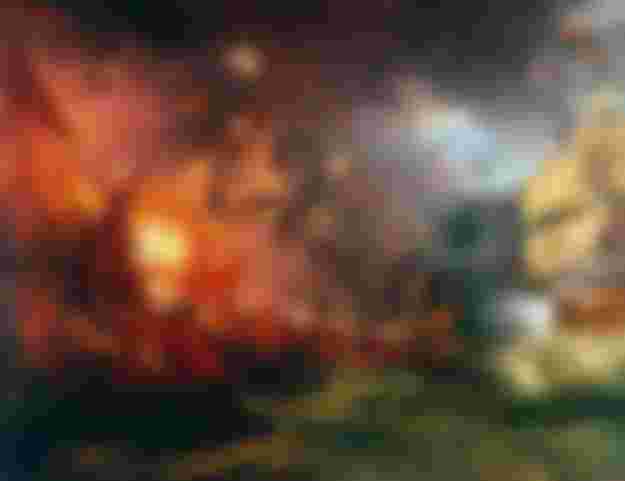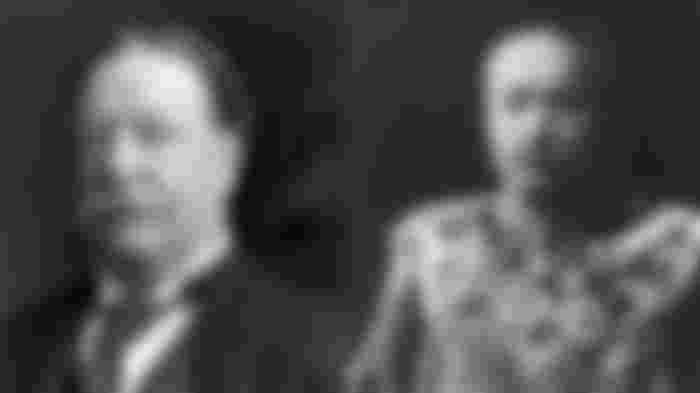THE ENGLAND NAVY DESTROYED THE SPANISH ARMADA
July 29, 1588

On the coast covered by Gravelines, France, the English fleet led by Sir Francis Drake and Lord Charles Howard destroyed the so-called "Spanish Armada" of Spanish fleets led by the Duke of Medina-Sidonia.
It was July 21 when English warships began bombing a large fleet of Spanish warships numbering 130 ships. Many of them were destroyed by the long-range artillery of the English ship, as they continued to advance. Some of the abandoned Spanish ships landed in the port of Calais, France where their position was open to English pursuers.
As of midnight on July 29, the English fleet sent eight fireships to fire on Spanish ships docked at Calais. These fireships are capable of firing cannons automatically. The Spaniards were startled by this sudden onslaught of fireships so they hurried to break their anchors, but in their haste, they were no longer formed, and at dawn, they were ambushed by English warships at Gravelines, France. . Since there was not enough time for the Spanish fleet to organize, the remaining ships fled north from the English channel. The English won that battle, and they began to chase the fleeing Spaniards as far as the ocean covered by Scotland.
The condition of the Spanish ships was miserable. Ships are overcrowded, and they are running out of food and other vital supplies. Worst of all, they have also become enemies of nature. More Spanish ships were destroyed in strong storms. This time, the so-called "invincible" Spanish army returned home disappointed, ruined, and defeated. Nearly half of the original 130 Spanish ships and 15,000 soldiers returned to Spain in October.
England's long-range artillery, and the brave and daring leadership of Sir Francis Drake, and unwavering determination to defend England from Spanish occupation were the factors in England's victory under Queen Elizabeth I, not only from Spanish Armada but also the entire English channel.
With the blessing of Pope Sixtus V, King Philip II of Spain planned to invade England, one of its naval rivals, in response to an ambush by English ships in Spanish trade. Queen Elizabeth, I supported the Dutch rebellion from the Spanish conquest, so in addition to responding to the English ambush, King Philip also wanted Protestant England to be restored to Catholicism if he succeeded in conquering England. In 1587 the ships that would make up the large Spanish fleet were completed, but several times the attack of Sir Francis Drake's ships hindered the advance of the Armada. On May 19, 1588, Spanish ships began sailing to confront England, but eventually, King Philip II's ambition to defeat England and become Catholic again failed.
ARC DE TRIOMPHÉ ZA PARIS, FRANCE INTRODUCED
July 29, 1836

The Arc de Triomphé, or Arc of Triumph, is one of the most famous sights in Paris, France. The arch is located at the western end of the Champs-Élysées, in the middle of Place Charles de Gaulle, or formerly called Place de l'Étoile, adapted from the star-like shape of the roads that run through the square.
On this day in 1836, this giant arch was inaugurated and first opened to the public. Construction of the arch began in 1806 during the reign of Emperor Napoléon Bonaparte, to mark his victory at Austerlitz against the Austrians and Russians in December 1805. The architect Jean Chalgrin designed the arch but handed over the design of the arch to Jean. -Nicholas Huyot when the original architect died in 1811. The wooden mock-up of the said arch was completed in 1810, and construction continued until the Bourbon monarchy returned to France in 1815.
Construction on the arch stalled until 1833 when construction on the arch continued during the reign of King Louis-Philippe. The arch was opened in a grand ceremony in Paris, presided over by King Louis-Philippe in 1836. On December 15, 1840, a procession of the return of Napoléon Bonaparte's remains to its resting place at Les Invalides passed under the arch. . The Arc de Triomphé witnessed important parts of French history after Napoleon: the revolutions against the Louis-Philippe monarchy, the return of the Republic, the inauguration of the Eiffel Tower in 1889, until the Nazi German conquest of Paris in June 1940 and there -the liberation of Paris from the Germans in 1944.
The arch is 50 meters high, 22 meters wide, and 45 meters long, and each of the sculptures on the arch is carved by famous French sculptors. The design style of the Arc de Triomphé is neoclassical, adapted from the triumphal arc designs of the ancient Romans. There are four sculptures on each of the arch pillars, all of which are allegories of every important event in France during the French Revolution and the Napoleonic War; the Marseillaise in 1792, the Victory of 1810, Resistance and Peace in 1814, and the Peace of 1815, which became the beginning of peace in Europe after the fall of Napoléon. Also engraved on the ceilings and walls of the arch are the names of veterans who fought in the French Revolution and the Napoleonic War, the battles won by France, and also in the center of the arch is the Tomb of the Unknown Soldier, who died in fighting during the First World War.
There is a carriage sculpture that once stood at the top of the arch from 1882 to 1886, La Triomphé de la Revolution, designed by Alexandre Falguiére, and allegory of the French Revolution.
Today the Arc de Triomphé hosts important gatherings in France, specifically the military parade every Quatorze Juillet. And like many structures in Europe, the Arc de Triomphé continues to undergo rehabilitation as it gradually loses its white color due to air pollution.
THE TAFT-KATSURA AGREEMENT
July 29, 1905

On this day in 1905, an agreement between Japan and the United States was signed by American Secretary of War William H. Taft and Japanese Prime Minister Katsura Taro. The Taft-Katsura Agreement is a memorandum containing the positions of the two powerful countries on what is happening in East Asia, in particular the situation of the Korean peninsula and the Philippines after Japan's victory in the war against Russia in 1905.
On July 27, 1905, William H. Taft arrived in Japan to talk to Prime Minister Katsura Taro about their future position on the situation in Korea and the Philippines, which at that time were ruled by powerful nations. According to the agreement signed by the two, Japan recognizes America's interest in the Philippines and has no intention of occupying it. Japan also stressed in the agreement that it wants to maintain peace in East Asia, which can be achieved through good relations and understanding between Japan, America, and Britain. The Agreement also detailed America’s respect for its occupation of Korea, while Japan also respected the idea that the Philippines should be ruled by a stronger country like the United States.
For the Koreans, it was this agreement that broke the agreement between the King of Joseon and the President of the United States, and for the Koreans, America could no longer be trusted when it came to the issue of Korean sovereignty.
This agreement between Japan and the United States lasted until December 7, 1941.
ESTABLISHED THE PHILIPPINE TUBERCULOSIS SOCIETY
July 29, 1910

During the early days of the Americans' stay in the Philippines, the country faced widespread public health problems. One of the most recorded illnesses of people at that time was due to tuberculosis. At a regional health meeting held in Manila in 1910, an alarming number of deaths due to tuberculosis were reported to be estimated at 40,000.
After a meeting of some concerned citizens and public officials, the concept of establishing the Philippine Anti-Tuberculosis Society (PATS) was developed and its establishment was later approved. Under the leadership of its president Mrs. Eleanor Franklin Egan, their organization has responded to serious cases of tuberculosis that have affected some Filipinos.
In 1934, then-Senate President Manuel L. Quezon recognized that tuberculosis was a major threat to public health. That is why he promoted the Sweepstakes Law and 25% of its proceeds will go for the funds of the Philippine Anti-Tuberculosis Society. In recognition of his support to the organization, the Santol Sanatorium, built-in 1918, was named after him and renamed the Quezon Institute in 1938, inaugurated by Manuel L. Quezon himself. It served as a hospital for people affected by tuberculosis.
Other operations of the organization were halted due to the outbreak of World War II in the country. Japanese soldiers occupied the Quezon Institute and ordered the transfer of medical staff to San Juan De Dios Hospital in Intramuros, Manila. Some equipment from the Quezon Institute was stolen at that time.
Anti -TB programs were revived after the government was re-established after the war in 1945. President Sergio Osmeña promoted the allocation of one million pesos for these programs of which Php 800,000 to help PATS. The US Army returned equipment and medical supplies to the organization and reopened the Quezon Institute. In 1957, President Ramon Magsaysay increased the allotment of the Philippine Charity Sweepstakes to one million pesos for the organization.
Later, the organization became incorporated and became the Philippine Tuberculosis Society, Inc. (PTSI) on February 29, 1960, and they were registered on March 11, 1960, with the Securities and Exchange Commission.
PTSI continues to serve to this day to assist in the prevention, control, and cure of tuberculosis in the country.
References:
History.com Editors (n.d.). Spanish fleet defeated. History.com. https://www.history.com/.amp/this-day-in-history/spanish-armada-defeated
Wikipedia (n.d.). Arc de Triomphe. https://en.m.wikipedia.org/wiki/Arc_de_Triomphe
Lindsay, J.M., & Shortridge A. (2020, July 31). TWE remembers the Taft-Katsura memorandum. Council on Foreign Relations. https://www.cfr.org/blog/twe-remembers-taft-katsura-memorandum-0%3famp
Wikipedia (n.d.). Taft-Katsura agreement. https://en.m.wikipedia.org/wiki/Taft%E2%80%93Katsura_agreemen
The Kahimyang Project (n.d.). Today in Philippine history, on July 29, 1910, the Philippine Anti-Tuberculosis Society was founded in Manila. https://kahimyang.com/kauswagan/articles/1881/today-in-philippine-history-july-29-1910-the-philippine-anti-tuberculosis-society-was-founded-in-manila



